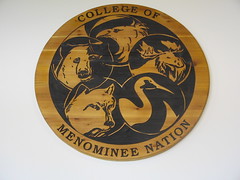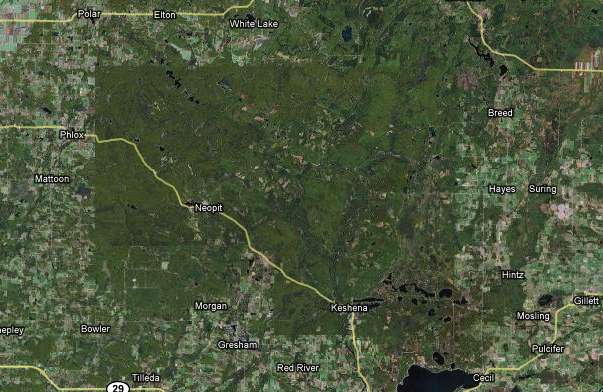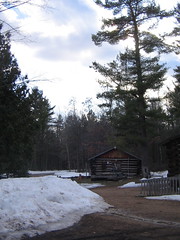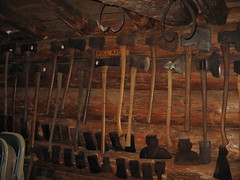Gabe’s account of our trip to the Menominee and Stockbridge-Munsee libraries, archives, museums.

Most students tend to spend their spring breaks in warm locals like Puerto Rico, but not us dedicated TLAMers. Instead, many of us opted to head north and visit the libraries, archives, and museums on the Menominee and Stockbridge-Munsee Reservations. We saw a lot, learned a lot, met a lot of dedicated people, and even had a good time on our spring break excursion.
Menominee Tribal/County Library
Our first stop was at the Menominee Tribal/County Library where we met with Mike Wilber, the Library Director. Over coffee he told us how the library got started and keeps running. His library is part of the Nicolet Federated Library Sy stem and gets a significant amount of use from the community. One of the things that surprised me was that the Menominee Library is actually a net lender to other libraries in the system. Mike told us that one of the challenges is getting the word out to people about free services, such as inter-library loan. Often times people are unclear on how their service works and avoid using it because they do not want to bother anyone. Mike also shared with us his dream of getting a new library closer to main road one day. As it stands now, users need to find their way through a few back streets without sidewalks to get to the library. We ended our visit with him asking him to consider us for help with any future development projects, and offering our time with grant writing projects in particular.
stem and gets a significant amount of use from the community. One of the things that surprised me was that the Menominee Library is actually a net lender to other libraries in the system. Mike told us that one of the challenges is getting the word out to people about free services, such as inter-library loan. Often times people are unclear on how their service works and avoid using it because they do not want to bother anyone. Mike also shared with us his dream of getting a new library closer to main road one day. As it stands now, users need to find their way through a few back streets without sidewalks to get to the library. We ended our visit with him asking him to consider us for help with any future development projects, and offering our time with grant writing projects in particular.
College of the Menominee Nation Library
After a hasty lunch of sugar products we made our way to the College of the Menominee Nation to visit their new library.  The library building is an impressive wood and stone structure, and one of the largest on the campus. Here we met with Maria Escalante, the Library Director, who gave us a tour showing us the collections and describing improvements that are still underway. This is certainly no musty old library. The building layout is open, spacious, and full of windows. In fact, there were so many windows in the original plan that Maria complained to the architect that she needed at least a little wall space for serials shelving.
The library building is an impressive wood and stone structure, and one of the largest on the campus. Here we met with Maria Escalante, the Library Director, who gave us a tour showing us the collections and describing improvements that are still underway. This is certainly no musty old library. The building layout is open, spacious, and full of windows. In fact, there were so many windows in the original plan that Maria complained to the architect that she needed at least a little wall space for serials shelving.
After the tour we talked in the atrium under a large logo for the college.

One of the main things we discussed was the process that led to the impressive building that they have now. Her short answer: the college president is dedicated to the library and early on committed to making it a priority. She also receives support from having a proactive grant writer at the college that finds the funding she needs for projects.
The library space is not the only thing growing at the college. Staffing is also increasing. Maria has even tapped her mother to do part-time cataloging. Her mother briefly discussed issues relating to cataloging materials at the college in an appropriate manner. The library recently hired an archivist to sort out their existing collection in preparation for more materials and will be looking for more help as their services and hours expand. Eventually the second level and basement for the library will be finished, which will allow for more bookshelves, a library instruction and meeting area, and an archives (possibly) in the basement.
Menominee Indian High School Library
Our next stop was at the Menominee Indian High School Library, where we met with the ultra-hip librarian, Ben Grignon. Ben is a graduate of the Knowledge River program at the University of Arizona, a program focusing on Hispanic and American Indian library and information issues.
The high school library is at the very heart of the building. Most of the school looks like what you might expect from most high schools, but as soon as you walk into the library the first thing that you have to do is look up at the wooden dome that encompasses the large room you enter. The dome is in a circular lodge-pole design and books line the walls underneath it. Interspersed throughout the open space are short shelves, display cases of artifacts, and work tables . One of the most noticeable features in the library is the collections of pictures from each of the graduating classes hanging above the books. According to Ben people from the tribe often come to the library just to see the pictures. With everything that there was to take in Ben decided to let us browse first and ask questions later. Among the things to see: a large tupperware bin where worms were composting old office paper.
When we regrouped again to speak with Ben we went to a small side room with ambient light coming from a ceiling covered in miniature lights. Here was a multimedia room were Ben proudly showed us things like a student hip hop project using lyrics from the Odyssey. Perhaps most significant, however, are the Ben and his students’ efforts to digitize numerous tapes on the Menominee language and make them available for learning (I’m guessing their efforts are paying off since I overheard some young students working on computers at the college talking to each other in a language that sounded entirely unfamiliar to me).
In another room off the main library Ben showed us the collection he maintains of books, tapes, and videos specifically on the history and culture of the Menominee and other tribes.
I think Christina J spoke for all of us when she exclaimed to Ben “Wow, Ben I wish you were my high school librarian! You are so cool!” He was definitely doing some very cool things with the library there.
Menominee Logging Museum
After meeting Ben we couldn’t help ourselves, we just had to meet his uncle Dave Grignon who heads up the Menominee Logging Camp Museum, which houses the largest collection of logging tools in one place in the world. We also met with Rebecca Alegria, a researcher/planner there, and the museum tour guide, Jean M. Cox. Now, this is no run of the mill logging museum (sorry, I couldn’t help using the pun). The museum also serves as the Menominee cultural preservation office and highlights the innovative sustainable forestry practices that make the Menominee known worldwide. To get an idea of how well-run the forest is look at the image from Googlemaps here.

You can see the boundaries of the reservation because everything outside of the reservation is a distinctly less-vibrant shade of green. At this point I couldn’t help but be very impressed with the outright efforts by the Menominee at sustainable practices.

The most noticeable thing to me after arriving at the museum was the sound when I stepped out of the car: the wind in the trees. The logging museum is surrounded by forest. There were some open grassy areas, but there was not a single ugly clear-cut in sight here, nor would we see one on our trip.
Dave and Rebecca discussed with us how their museum works and the preservation efforts they undertake. Unlike some other tribes we have visited, the Menominee have been very proactive in using the NAGPRA to repatriate remains and artifacts. Since there is no other Menominee reservation there are no difficulties from negotiating with other bands about how the artifacts and remains will be returned. Dave himself has participated in reburying numerous remains and cooperated with institutions in Wisconsin to return items that belong to the tribe.

Unfortunately, most of the museum was closed during our visit for the winter. They have to close for the winter because the museum is a reproduction of a base logging camp; meaning it is mostly outside. The part that we were able to see was the long bunk house, where Jean showed us around. I don;t think I will ever see as many axe heads, picks, and chains in one place ever again.
Dinner with Lynn
At this point you may be thinking could there really be more to our day? After all, we drove some three and half hours to get to Menominee from Madison. But we had the opportunity to meet with Lynn Skenandore who helped establish a school library at Menominee. The talked with us about the challenges of getting kids to read and the ways in which she has been successful. She also talked about the larger issues for students growing up on the reservation going on to school elsewhere.
The End of the Day . . .
Or is it? We checked into the Konkapot Lodge on the Stockbridge-Munsee Reservation, which I highly recommend. It is constructed from the giant timbers of trees that fell during a strong storm and is an easy place to feel at home. Some of us turned in and some of us headed for the casino, but if you want to hear about that you’ll have to ask me in person 😉
More about our visit the next day at Stockbridge-Munsee soon!

What a great write-up! I am wondering if Maria’s mother mentioned whether they’re addressing those cataloging issues in any particular way…